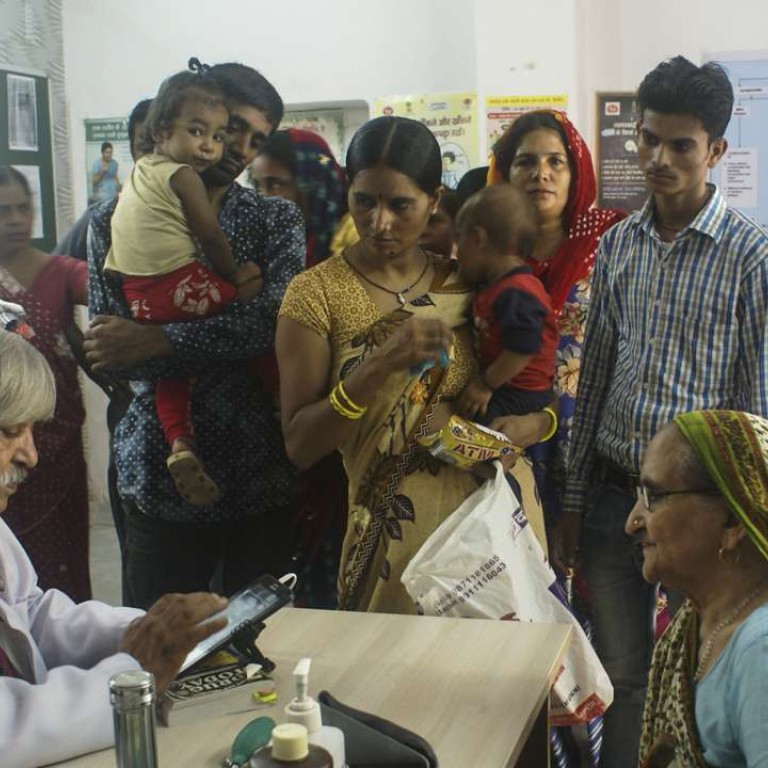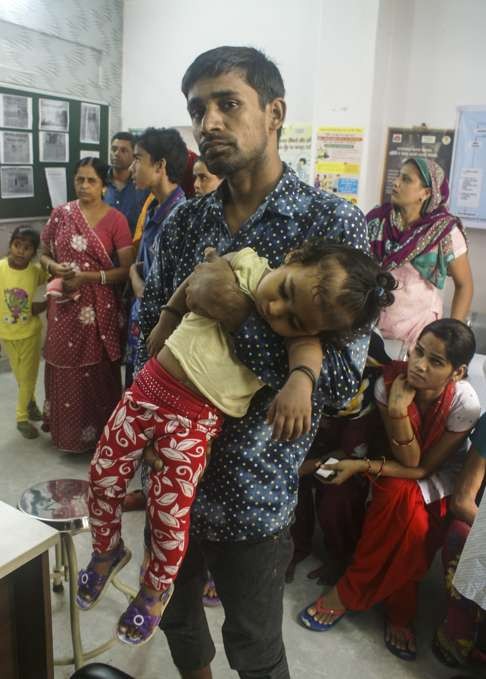
Neighbourhood clinics bring healthcare to India’s poor
Doctors see a million patients in first five months of New Delhi pilot project
Whenever Arif Wazir got gastrointestinal problems, he used to visit Ram Manohar Lohia, a 1½ -hour bus ride away and the nearest government hospital to Todapur, north Delhi. Bursting at the seams, Wazir, a slum dweller who sells shoes on a street stall, waited for five to six hours to see the doctor, in sweltering corridors filled with the chaos of many other anxious people. Getting there cost him 200 rupees (HK$23), more than a quarter of his daily wage. The only bonus: the hospital’s treatment is free.
But the most recent time he fell ill, a relative told him to visit a mohalla clinic in Todapur, a bold new experiment by the Delhi government to take good and free primary healthcare to the doorsteps of the poor. “Mohalla” means neighbourhood or community.
When Wazir walked in at 9.30am, he found a clean, air-conditioned room. It was packed – September brings a raft of monsoon-related illnesses – but Dr Richpal saw him in 40 minutes. The diagnosis was jaundice. Wazir got his medication from a medicine vending machine inside the clinic in seconds and was back home in time to go to work. The consultation and medicine were free.
“I was so surprised. It was all so quick and easy. It’s a real luxury to have a clinic close to my home instead of wasting a whole day at a hospital,” says Wazir.

The New Delhi government has opened 105 such clinics in low-income areas all over the capital since April to offer a third choice to the poor who hitherto could do one of two things: go to one of the free but far away government hospitals or visit a private clinic where a hefty fee has to be paid.
Neither of these two options suit the poor. They live in unsanitary conditions in slums where stagnant water attracts flies and mosquitoes. Drinking water and food are often contaminated. Minor ailments arising from these conditions are common. Being able to go to a clinic in their neighbourhood makes much more sense than travelling six to seven kilometres for diarrhoea or fever, particularly when all they usually need is paracetamol or oral rehydration salts.
In addition, the government hopes the clinics will reduce the burden on over-stretched government hospitals. Delhi has one hospital bed for every 820 patients, forcing patients on occasion to share beds.
The mohalla clinic is situated either in rented premises or set up inside a portakabin (semi-permanent, temporary cabins) structure. The set-up cost is five per cent of the cost of constructing a normal brick-and-mortar clinic.
Since they are open from 9am to 1pm, any qualified doctor who wishes to practise part-time can work in the clinic. This appeals to retired doctors, newly qualified doctors looking for experience and female doctors, especially those resuming work after a break due to marriage or having a baby.

Dr Shoebul Haque has just qualified as a medical doctor and is continuing his postgraduate studies in maternal healthcare. He works in the mohalla clinic in Munirka, south Delhi. “This is perfect for me. I am paid 30 rupees by the government for consulting each patient. This gives me some income while continuing my studies. In the afternoons, I study,” says Haque.
At the Todapur clinic, Richpal is having a busy day. He is the perfect man for the job. A known public health administrator and doctor, he retired five years ago and joined one of the mohalla clinics when he heard of this novel idea of serving the community at their doorstep.
“Most of the diseases of ordinary people are communicable, infectious and contagious. We can prevent them spreading with early intervention. If we diagnose them early by being near patients – as we do here – then you are catching them during the incubation period before they spread throughout the community,” he says.
The city is in the grip of vector-borne diseases such as dengue, viral fever and chikungunya. Apart from the monsoon diseases, it is diarrhoea, hypertension, anaemia in women, pneumonia in children, skin allergies, vitamin D deficiency, asthma, and diabetes that Richpal commonly treats.

Anil Sethi, an auto rickshaw driver, has brought his three-year-old daughter Pinkie, who has been running a high temperature, to see Richpal. “I used to take her to a private clinic where I paid 400 rupees to see the doctor. The cost of the medicine was on top of that. I feel more relaxed about my family knowing this clinic is here for people like me,” says Sethi.
Richpal has Pinkie’s records on his tablet. All he does is key in Sethi’s mobile number. The consultations in all the clinics are digital and paperless. Some of the clinics also have a new device that conducts 50 common medical tests from a single blood sample, including blood sugar levels and cholesterol. The device means a fast diagnosis and a faster start to treatment because the results of most tests are known within an hour or so and are uploaded onto a data cloud for access by doctors using their tablets.
In five months of the pilot project so far, the 105 mohalla clinics have crossed one million patient consultations in total. Haque sees about 120 to 150 patients a day. Richpal sees about 80.
“Since the ailments are mostly not serious, a few minutes per patient are usually enough,” says Haque.
A private partner to the Delhi government, Wish, a non-profit organisation, has been providing the latest technology for these clinics including the tablet and the accompanying android-based application. Its other major contribution is the medicine vending machine.

Arti Singh, who has seen Richpal for joint pains, knows the machine spells security. “Some chemists sell fake drugs. With this machine, I know I am getting the genuine article, she says.
The machine was installed in the Todapur clinic and nine other clinics on a pilot basis, in collaboration with US Agency for International Development, which has funded it. If successful, it will be installed in all other clinics.
As with any experiment, issues have emerged in the mohalla clinic pilot. Since they are all located in low-income neighbourhoods, power cuts or slow internet speeds are sometimes a problem. Some patients have complained the wait is too long and the clinics have no X-ray machine.
But given how long urban healthcare has been ignored in the capital for many marginalised people, any improvement is welcome. “It’s the first concrete thing any government has done for people like me,” says Sethi.
By the end of the year, the government plans to set up 1,000 more mohalla clinics. Eventually, they will become a new network of primary health care for the majority of the capital’s 18 million plus citizens who cannot afford private care.

